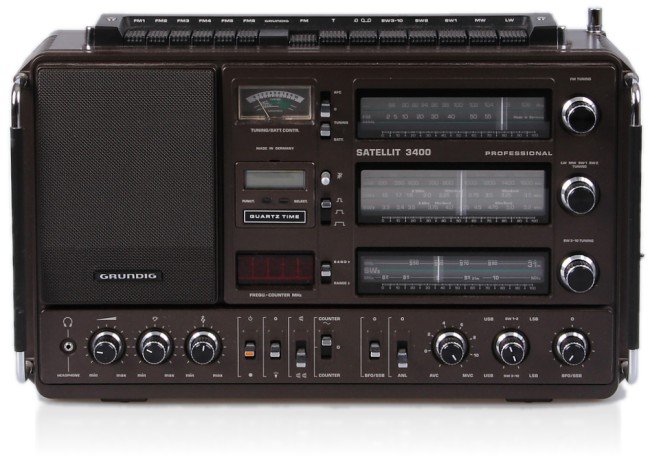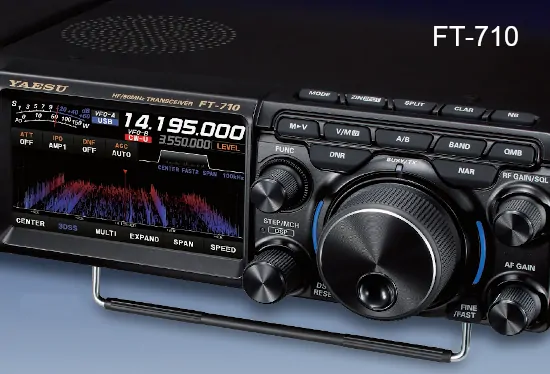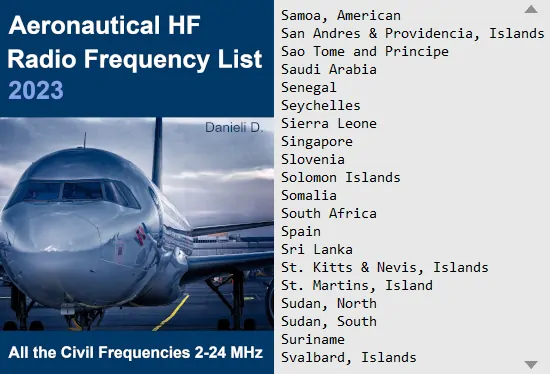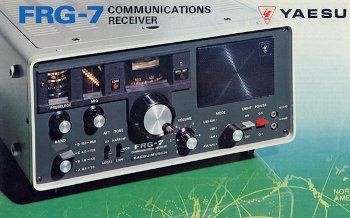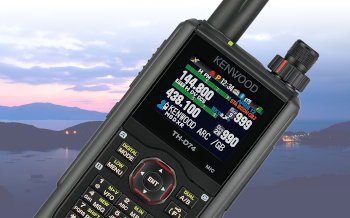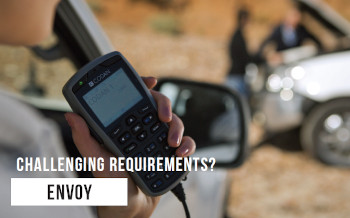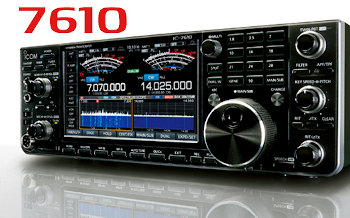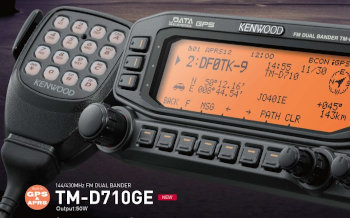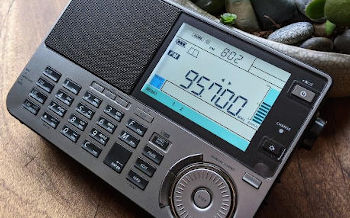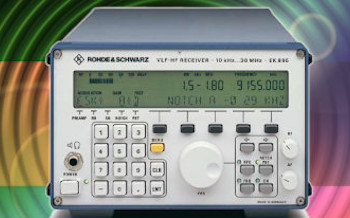
Digital hand-held scanner for 100 KHz ~ 1300 MHz. All analog & digital modes with auto-detect, advanced signal select functions, IPX5 water resistant. Ideated in Japan, year of introduction 2018.
Reference market : amateur-radio
AR-DV10 specifications
| General |
| Frequency coverage | |
|---|---|
| 0.1000 ~ 1300.0000 MHz [1] | |
| Mode | |
| CW / SSB / AM / FM / WFM / APCO25 / dPMR / DMR / TETRA / NXDN / Digital-CR / D-STAR / Alinco(EJ47U) / Yaesu(C4FM) | |
| Tuning step | |
| 10 / 50 / 100 / 500Hz / 1 / 2 / 5 / 6.25 / 7.5 / 8.333 / 9 / 10 / 12.5 / 15 / 20 / 25 / 30 / 50 / 100 / 500 KHz |
| Receiver |
| Sensitivity [2] | |
|---|---|
| SSB | 0.3 uV (10dB S/N) |
| AM | 1.6 uV (10dB S/N) |
| FM | 0.3 uV (12dB SINAD) |
| WFM | 2.6 uV (12dB SINAD) |
| Selectivity | |
| CW | 0.2 / 0.5 KHz (-3dB) |
| SSB | 1.8 / 2.6 KHz (-3dB) |
| AM | 3.8 / 5.5 / 8 / 15 KHz (-3dB) |
| FM | 6 / 15 / 30 KHz (-3dB) |
| WFM | 100 KHz (-3dB) |
| Digital modes | 6 / 15 / 30 KHz (-3dB) |
| RF attenuator | |
| 10dB | |
| AGC (Automatic Gain Control) | |
| Fast, mid, slow, OFF | |
| Frequency stability | |
| ± 5ppm with temperature from -10°C to +50°C | |
| IF (Intermediate Frequency) [3] | |
| 1° | 47.25 MHz |
| Features |
| Memory | |
|---|---|
| 2000 regular memories in 40 banks 2000 for skip scan 40 for programmed scan limits 3 VFO 1 priority channel |
|
| Display | |
| 6.1cm LCD 10 Hz frequency resolution Segment-bar signal meter |
|
| Antenna | |
| BNC 50Ω | |
| Power supply | |
| 7.4 VDC battery (Lithium-Ion, 2000 mAh nominal) 6.5 ~ 10.5 VDC external |
|
| Power consumption | |
| 240 mA typ 500 mA max |
|
| Audio power | |
| 700mW on 16Ω internal speaker 200mW on 8Ω external earphone |
|
| Audio output | |
| Jack 3.5 mm headphone | |
| Connections | |
| Micro-USB |
| Mechanical and environmental data |
| Operating temperature | |
|---|---|
| from -10°C to +50°C | |
| Dimensions | |
| 65 (W) x 137 (H) x 41 (D) mm (including battery pack, excluding projections) | |
| Weight | |
| 420g (including battery pack, antenna and belt clip) |
- The USA consumer version has cellular frequencies blocked and analog voice descrambler function deactivated by hardware.
- Typical values not referenced to specific frequency.
- Direct sampling SDR architecture in specific bands, without frequency conversion.
AR-DV10 is a hand-held Software Defined Radio, the 100 KHz to 1300 MHz signals are converted to a super heterodyne 47.25 MHz intermediate frequency and then digitized with a A/D converter. AM and FM broadcast bands are digitized after direct convertion in I/Q format. Signals are then processed by an Altera Cyclone IV FPGA and an Analog Devices Blackfin DSP for demodulation.

The DV10 revolutionary features such as multi-digital modes reception and auto-detection of digital modes have been made possible thanks to these latest processing technologies. Some of its outstanding features are the automatic detection of P25 / dPMR / DMR / NXDN / Digital-CR / D-STAR / Alinco / Yaesu modes; fast memory scan and program search; receiving support functions such as step-adjustment / offset / priority reception; MicroSD card support for recording / memory data / firmware updates; dedicated radio IC for 0.52-1710kHz AM and 64-108MHz FM broadcasts; IPX5 water resistant.
AR-DV10 digital voice mode compatibility chart :
| ALINCO DIGITAL (EJ-47) | |
|---|---|
| Mode variant | Voice mode F1E |
| Encoding / Modulation | GMSK |
| Compatible vocoder | AMBE |
| DIGITAL-CR | |
| Mode variant | --- |
| Encoding / Modulation | Non encrypted / C4FM
Scrambling / C4FM |
| Compatible vocoder | AMBE+2 |
| DMR | |
| Mode variant | TIER 1, TIER 2, Motorbo |
| Encoding / Modulation | Non encrypted / C4FM |
| Compatible vocoder | AMBE+2 |
| dPMR | |
| Mode variant | dPMR446 and TIER 1 |
| Encoding / Modulation | C4FM |
| Compatible vocoder | AMBE+2 |
| D-STAR | |
| Mode variant | DV |
| Encoding / Modulation | GMSK |
| Compatible vocoder | AMBE |
| NXDN | |
| Mode variant | Regular mode |
| Encoding / Modulation | Non encrypted / C4FM
Scrambling (15 Bit) / C4FM |
| Compatible vocoder | AMBE+2 |
| APCO25 | |
| Mode variant | PHASE 1 |
| Encoding / Modulation | Non encrypted / C4FM |
| Compatible vocoder | IMBE |
| TETRA | |
| Mode variant | Direct mode |
| Encoding / Modulation | Non encrypted / shift QPSK |
| Compatible vocoder | TETRA codec |
| YAESU DIGITAL | |
| Mode variant | V/D mode |
| Encoding / Modulation | C4FM |
| Compatible vocoder | AMBE+2 |
An useful function is the "STEP-ADJUST", when the array of desired receiver frequencies is not compatible with the default step frequency. Step-adjust allows setting the frequency steps accordingly. The following example describes a situation when a 20kHz frequency channels needs to be adjusted (offset) to 10kHz.

The step-adjust function on AR-DV10
Please note, the AR-DV10 is supplied with a flexible rubber antenna to be attached to the 50 Ohm BNC jack located on the top of the receiver. Due to physical limitations, the supplied flexible rubber antenna is not ideal for reception of LW, MW or SW frequencies. Although it does work to some extent, a dedicated external antenna should be connected for optimal reception of those bands.
Firmware updates
On internet AOR site you can free download the firmware updates for AR-DV10. The "1807A 2018/07/13" firmware feature improvements as; better frequency accuracy through additional automatic temperature compensation by FPGA/CPU; better P25 and DMR decoding; better SD card compatibility for recordings; CTCSS, DCS, reverse tone, voice scramble user settings now displayed during reception.AR data editor
A convenient browser based memory data editor for the AR-DV1 and AR-DV10 receivers. The editor allow to load, edit and save your receiver's memory channel data. Create new frequency databases. File format conversion between AR-DV1 and AR-DV10. In other words, a frequency database of one receiver can be opened and saved into a format the other receiver can understand.COSPAS-SARSAT decoder
Optional COSPAS-SARSAT distress beacon decoder function was added (to enable this feature you need also to purchase an unlock key). Such beacon are activated by persons, aircrafts or vessels in distress. AR-DV10 is the world's first handheld radio receiver to feature this unique fuction. It allows to receive both the beacon's analog 121.5 MHz as well the digital 406 MHz signal which indicates the GPS location and ID of the beacon owner. The AR-DV10 can of-course display the GPS and ID details on its LCD.Earphone antenna
When the earphone antenna cable function is activated, the cable acts as an antenna for the FM Broadcast band (64-107.99999MHz). Earphone reception can be convenient when listening while on the move such as for example in the train where the flexible rubber antenna would not be convenient.Descrambler
Scrambled analog voice transmissions can be decoded with the V.SCR function. The scrambler is sometimes used in public service radio, automobile racing and cordless telephones. This function is limited to FM mode with IF bandwidth of 6kHz and 15kHz. (not available in the USA consumer version).Signal's functions
Advanced setting give access to NXDN / D-CR scramble code, RAN (for NXDN mode), NAC (for P25 mode), color codes and slot selection (for DMR mode). CTCSS / DCS & reverse tone for analog mode: Continuous tone-coded squelch system (CTCSS) and Digital-code squelch (DCS) is a function which opens squelch only when a preset tone frequency is detected in the signal. Otherwise the audio will be muted. For reverse tone operation squelch reacts in the opposite way, that is the squelch "closes" when the designated tone is detected, and it remains open for all other tone frequencies (this system is used mainly in Japan).Squelch
The squelch function quiets the background radio noise when no signal is present. It operates in analog modes and the digital auto-mode. There are two types of analog squelch: NSQ (noise squelch) used for FM mode. LSQ (level squelch) used for AM, LSB, USB, CW modes. The receiver automatically selects the appropriate squelch type for optimal performance. However, if needed the squelch type can be forced to desidered setting.Accessories
Supplied accessories are the large capacity Lithium-ion battery pack, AC power adapter, alkaline battery tray, cigarette lighter DC/DC converter, fast charger cradle.
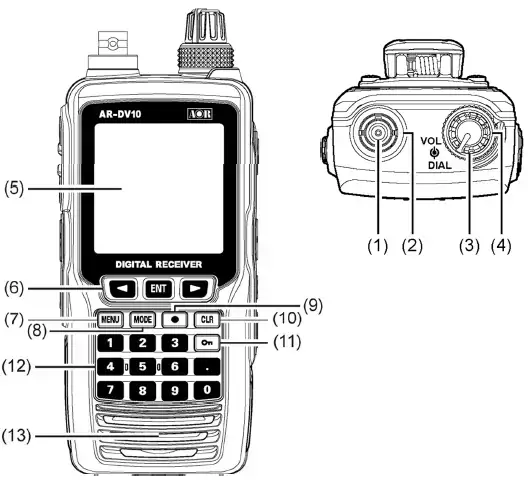
AOR AR-DV10 top and front panel
| Reference / Description | |
|---|---|
| 1 | Antenna jack (BNC) Attach the supplied flexible antenna or connect an external antenna. |
| 2 | Antenna ring Covers the gap between the antenna and the jack. Remains on the jack when the antenna is removed. |
| 3 | VOLUME (inner) knob Turn this (inner) control clockwise to increase the volume and counterclockwise to decrease the volume. |
| 4 | DIAL selector (outer) knob Tunes the frequency up or down and selects menu items. |
| 5 | LCD display Shows selected operating conditions. |
| 6 | Cursor keys and [ENT] key [<] and [>] are used to change the frequency or select an item displayed on the LCD. Press the [ENT] key to store the selection or entered values. The [ENT] key is also used to switch VFOs. Press and hold the [ENT] key to display the memory channel registration menu. |
| 7 | [MENU] key Displays the MENU-TOP screen. |
| 8 | [MODE] key Displays the receive modes menu. |
| 9 | [•] REC key Starts/stops audio recording to the SD card. |
| 10 | [CLR] key Cancels the current operation or returns to parent menu. |
| 11 | Key lock Press and hold to enable/disable the lock feature. When enabled, all controls except VOL and PWR will be disabled. |
| 12 | Numeric keypad The keypad is used when setting frequencies, bank & channel numbers, or entry selections in a menu. |
| 13 | Loudspeaker |
AR-DV10 left and right panel :
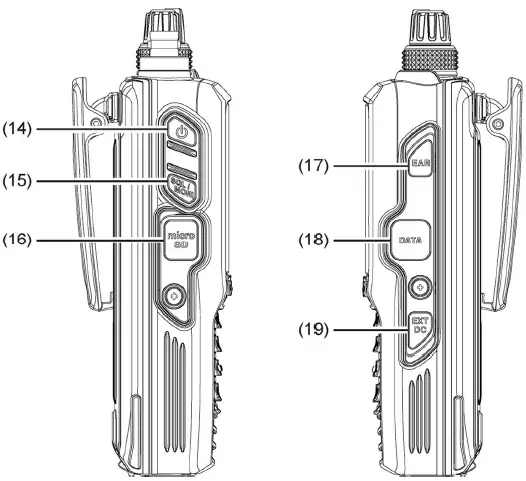
AOR AR-DV10 left and right panel
| Reference / Description | |
|---|---|
| 14 | POWER switch Press the switch briefly to turn the receiver ON. Press and hold it for 3 seconds to turn the receiver OFF. |
| 15 | SQL/MONI (squelch/monitor) switch Press to enable the squelch value to be adjusted with the DIAL. Press again to validate and save the setting. Press and hold this button to open the squelch manually, to listen for weak signals. That is the MONITOR function. |
| 16 | microSD card slot Lift the rubber cover to install the supplied SD card. The SD card is used for audio recording & playback. The card is also used to backup and restore memories, memory banks, system & CSV data, as well as to install firmware updates. |
| 17 | EARPHONES jack 3 pin 3.5mm, mono output. Lift the rubber cover to connect earphones. A menu setting allows the earphone cable to act as an antenna for FM Broadcast band (64-108 MHz, 100 kHz IF bandwidth only). |
| 18 | DATA jack USB mini-B socket. Lift the rubber cover to connect a USB cable for command control. |
| 19 | EXT DC jack To power the receiver from an external source, connect either the supplied AC power adapter or the cigarette lighter DC/DC converter. |
AR-DV10 price
We have collected for your convenience the Aor AR-DV10 sale price (US Dollar) and its trend over time. Useful to guarantee a cheaper purchase of this radio and to put it for sale in the second-hand market. Of course offers, accessories, warranty terms and conditions can lead to different figures.
|
|
|
|
| USD 1314.95 | 2023-mar | Brand-new |
|
USD 1108.00 (808GBP) |
2021-oct | Brand-new |
| USD 999.00 | 2018-oct | Brand-new |
AR-DV10 review
| Scarabaeus | January-13 2022 |
AR-DV10 - portable analog-digital WidebandReceiver: In 2022 I would expect from a modern digital wideband receiver DRM (xHE AAC audio) and DAB+ reception as an update or upgrade possibility (payable?). Perhaps in next time ;-)
Stay up to date! - Me, AOR or both?
Sensitivity on FM Broadcast with its own Radio IC is not good at all. Perhaps DAB+ would do better and this should not be a problem with a FPGA by Altera.
Battery Consumption is very heavy, there is urgent need for a bigger Battery Pack with more than 3000 mAh.
[End post]
Your opinion on merits, defects, experiences, with this radio set is welcome. Write your review, after a technical evaluation by our staff if found suitable will be published on this page. We thank you for your precious contribution.
